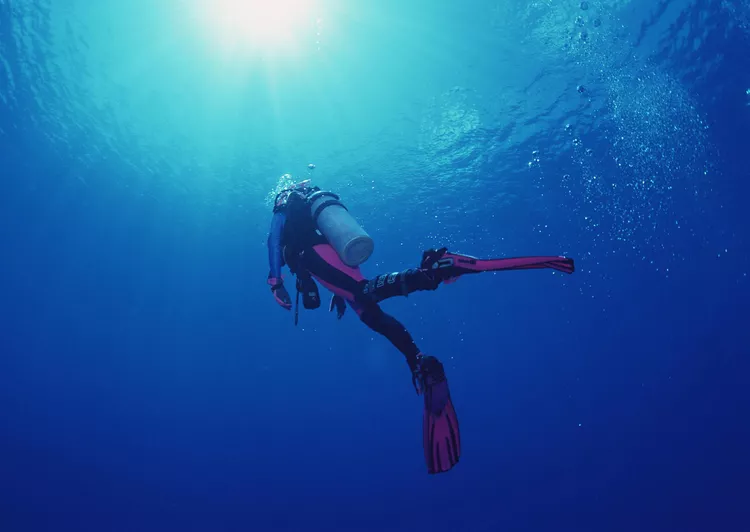Summary
- What is a No-Decompression Limit?
- What Determines the No-Decompression Limit for a Dive?
- What Factors Determine How Much Nitrogen a Diver Absorbs?
- When Should a Diver Calculate His No-Decompression Limit?
- Have a Contingency Plan
- Don’t Push No-Decompression Limits
- The Take-Home Message Regarding No-Decompression Limits
A no-decompression limit (NDL) is a time limit for the amount of time a diver can stay at a given depth.
No-decompression limits vary from dive to dive, depending upon depth and previous recent dive profiles. A diver who remains underwater beyond the no-decompression limit for his dive cannot ascend directly to the surface but must pause periodically during ascent to mitigate the high risk of decompression sickness. Consequently, a diver should never exceed a no-decompression limit without specialized training in decompression procedures.
What Determines the No-Decompression Limit for a Dive?
Nitrogen plays a critical role in determining a diver’s no-decompression limit. Underwater, a diver’s body absorbs compressed nitrogen from the breathing gas. This compressed nitrogen is then trapped in the tissues. As the diver ascends, the trapped nitrogen slowly expands or de-compresses. The diver’s body must eliminate this nitrogen effectively before it expands too much, potentially forming bubbles that lead to decompression sickness.
If excessive nitrogen is absorbed, a normal ascent becomes hazardous, as the body may not eliminate the expanding nitrogen quickly enough to prevent illness. Instead, the diver must incorporate decompression stops to safely manage nitrogen levels during ascent.
A no-decompression limit is thus defined as the maximum duration a diver can remain submerged while still allowing for a direct ascent to the surface without undergoing decompression stops.
What Factors Determine How Much Nitrogen a Diver Absorbs?
The nitrogen level in a diver’s body, and subsequently their no-decompression limit, depends on several critical factors:
1. Time: The longer the diver remains underwater, the more compressed nitrogen gas is absorbed.
2. Depth: Increased depth means quicker nitrogen absorption, leading to a shorter no-decompression limit.
3. Breathing Gas Mixture: Air typically has a higher nitrogen content compared to other mixtures, like enriched air nitrox. Using a gas blend with lower nitrogen content allows for a longer underwater time.
4. Previous Dives: Residual nitrogen from prior dives can shorten the no-decompression limit for subsequent dives, especially if they occur within six hours.
When Should a Diver Calculate His No-Decompression Limit?
A diver must evaluate his no-decompression limit prior to each dive. Moreover, he should use a reliable method to monitor dive time and depth consistently. It is essential for each diver to independently calculate and adhere to his own no-decompression limit, as it can vary with minor depth changes and previous dive profiles.
Have a Contingency Plan
Having a contingency plan is crucial in case a diver mistakenly descends beyond the planned maximum depth or exceeds the no-decompression limit. To develop such a plan, a diver can calculate the no-decompression limit for a depth slightly deeper than the intended objective. For instance, if the planned depth is 60 feet, the diver should also calculate the limit for 70 feet. Thus, if the planned depth is exceeded, he can follow the contingency guidelines instead.
Additionally, being familiar with emergency decompression rules is vital. This knowledge will guide a diver on how to react if the no-decompression time is accidentally surpassed.
Don’t Push No-Decompression Limits
It is crucial to observe no-decompression limits as they significantly reduce the risk of decompression sickness. However, since these limits are based on experimental data and mathematical models, they cannot account for every individual’s unique physiology.
No two divers are the same; therefore, it is vital to approach no-decompression limits cautiously. A diver should always reduce maximum dive times when feeling exhausted, unwell, stressed, or dehydrated. Additionally, planning ascents a little before reaching these limits is wise. This way, if unforeseen circumstances delay an ascent, extra time will mitigate risks related to no-decompression limit violations.
The Take-Home Message Regarding No-Decompression Limits
No-decompression limits serve as valuable guidelines to help divers decrease the likelihood of experiencing decompression sickness. However, it is important to remember that these limits are not infallible. Therefore, each diver must understand his own decompression limit for every dive and adopt a conservative approach to diving practices.





